Mama Baldé (176cm/5’9″, 69kg/152lbs) came up through Portuguese side Sintrense’s youth academy until 2013 when, at 17 years of age, Baldé moved to Portuguese giants Sporting CP where he finished off his youth academy career and subsequently began his senior football career.
The attacker first left Portugal in 2019, joining French side Dijon for €665k After two seasons and 57 games with Dijon, the player went on to join fellow French side Troyes in 2021, this time for €3.5m, where he remains today.
At present, the 26-year-old is enjoying a positive Ligue 1 campaign, having contributed seven goals and three assists in 13 league appearances.
Baldé is a player who’s been shifted around the attacking part of the pitch a lot throughout his career, from one wing to the other, to the ‘10’ position and the centre-forward position. However, this season, he’s played primarily as a centre-forward and this has worked fantastically.
When played as a centre-forward during his career, Baldé has typically delivered for his team, and that’s definitely been the case this season, with the Guinea-Bissau international currently trailing just six other Ligue 1 players for league goals this term, equalling PSG forward and Barcelona legend Lionel Messi in that area.
Our Baldé tactical analysis piece, in the form of a scout report, looks at the forward’s key strengths and weaknesses as displayed by his 2022/23 performances with Bruno Irles’ Troyes. Our scout report aims to provide an in-depth analysis of the player’s role in Irles’ tactics, which was described as “the role that suits him perfectly” by teammate Tristan Dingomé recently, as well as where he’s currently lacking, though coach Irles has declared he’s “happy with what [Baldé’s] showing now”.
Ball-carrying
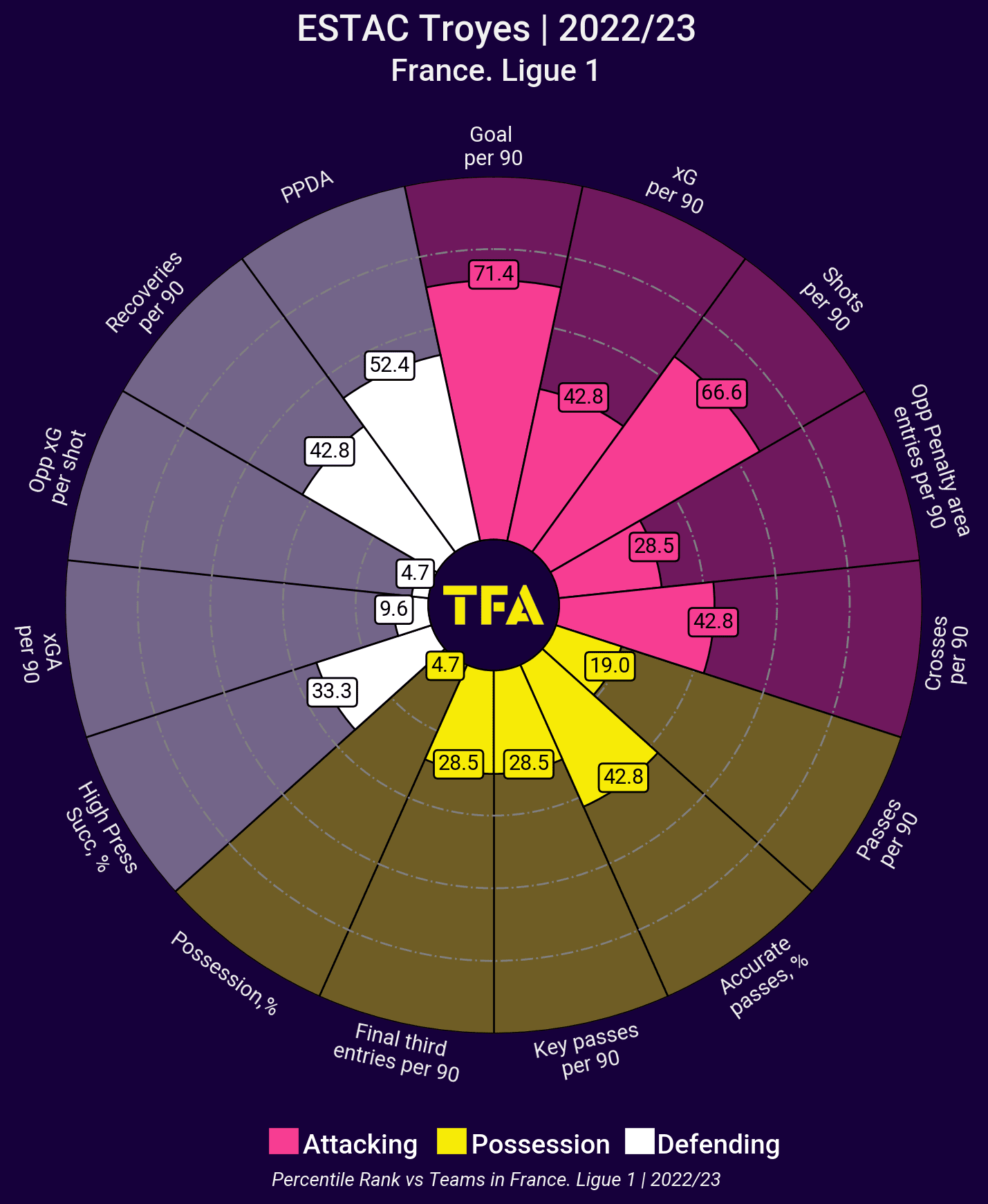
As figure 1 displays, Baldé plays for a Troyes side that keeps very little of the ball, primarily aiming to capitalise on transitions to attack. They tend not to press very high, more often than not being found in a mid-low block.
While they aren’t the most aggressive team in Ligue 1 in defending from the front, Baldé still has an important job to do in the defensive phases. The attacker is required to press aggressively on certain pressing triggers, and his defensive awareness along with work rate are key to Troyes’ defensive system working as intended, allowing them to generate the counter-attacks they aim to create.
This goes for his positioning when his team is defending deep too. Baldé will normally be deployed at the tip of his team’s defensive shape about midway through their own half of the pitch when Troyes are defending deep. Here, he must occupy some space for his teammates to find him quickly and safely in transition, so he can then help get his team upfield on the counter.
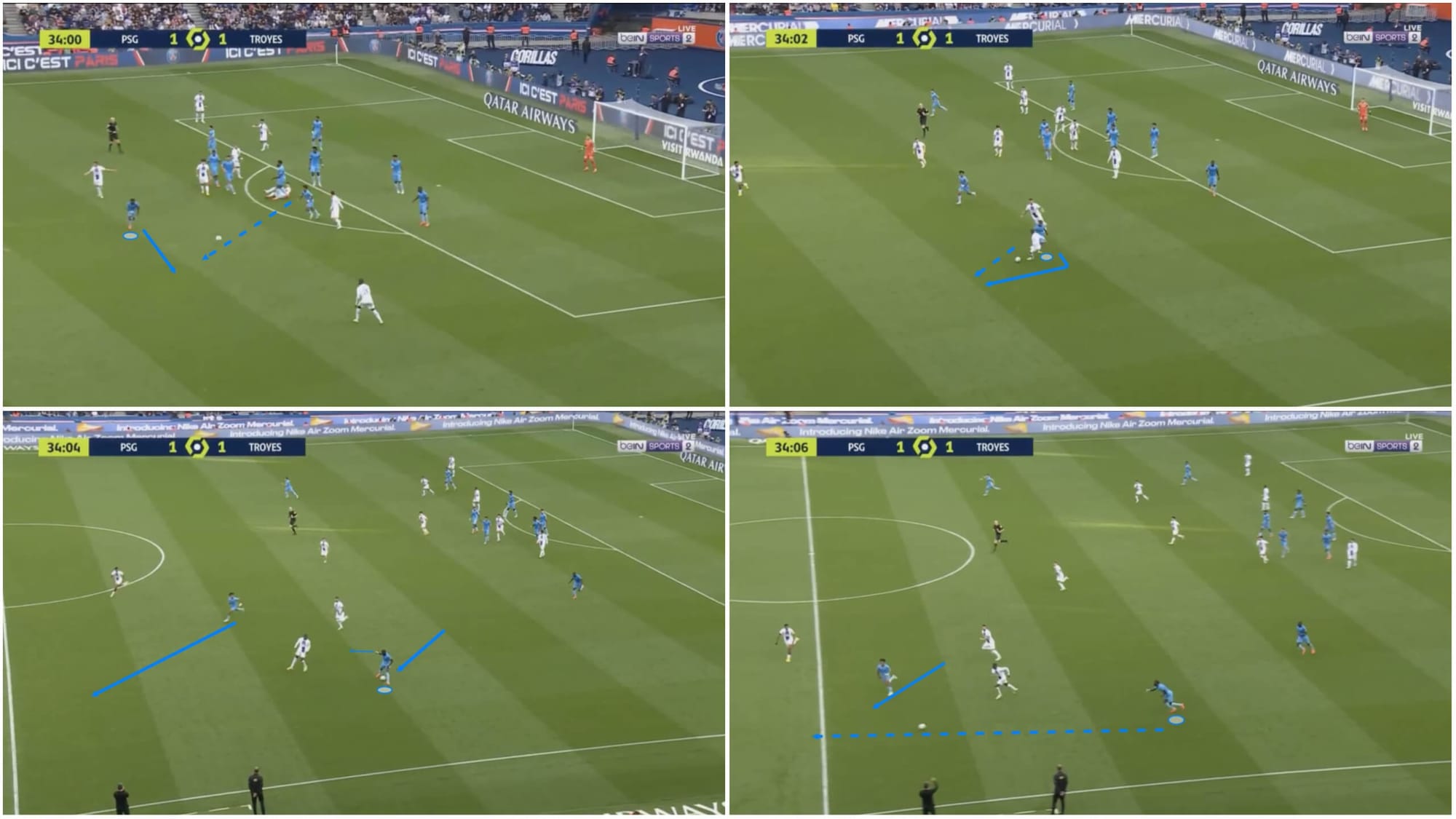
We see an example of Baldé positioning himself in space before running to gain possession of a loose ball on the edge of the area, carrying it upfield and then playing a teammate who has ran up in support through to enter the opposition’s half — an excellent example of the player’s crucial role in offensive transitions.
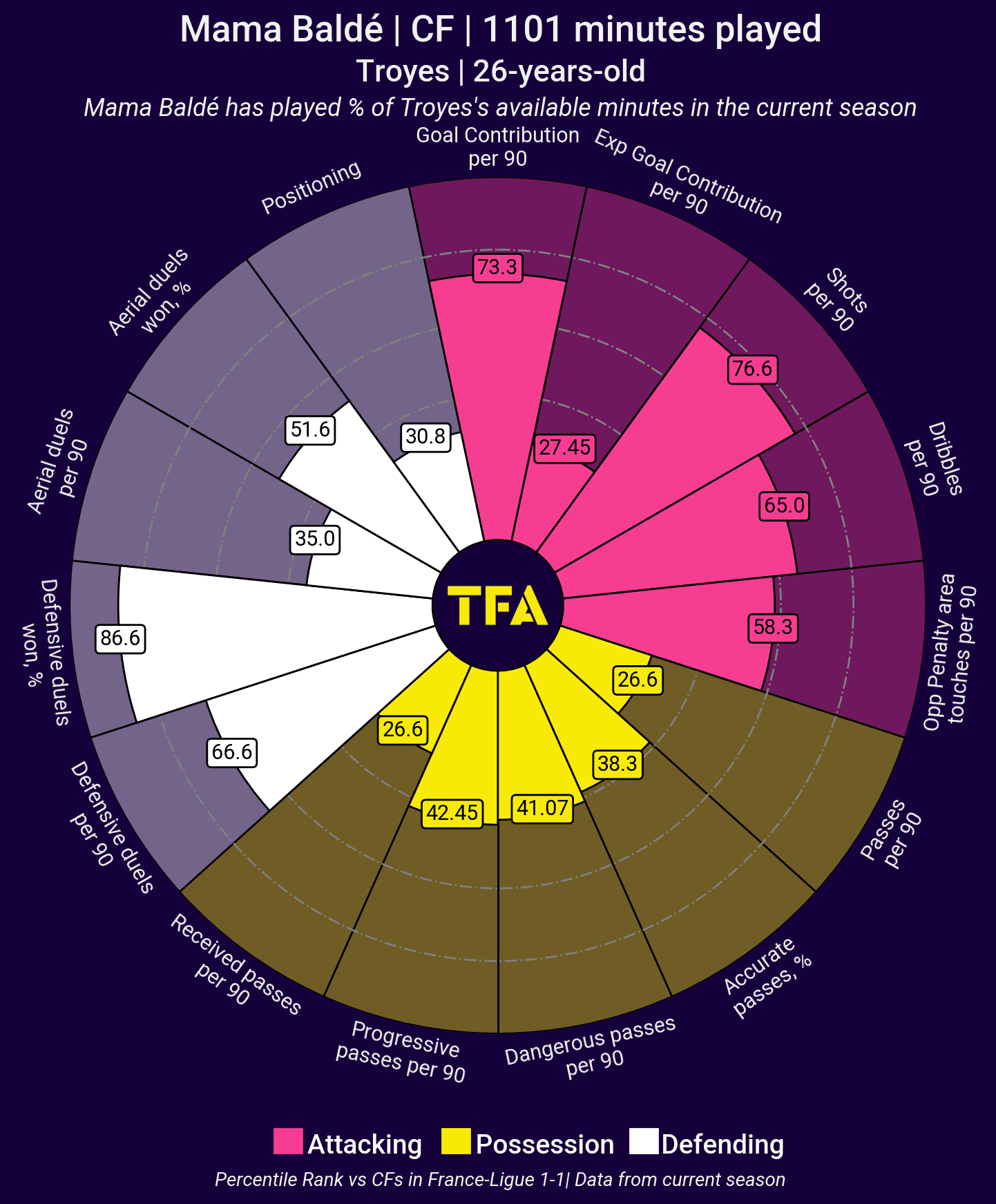
We’ll reference figure 3, a pizza chart of some key metrics for Baldé in Ligue 1 this season with percentile ranks comparing him with other Ligue 1 forwards, at a couple of different points throughout this article; firstly, with regard to his dribbling, we see that while he plays for a team that tends not to dominate possession, he makes plenty of dribbles per 90 — this holds for the player’s offensive duels too, where he ranks even more highly among his Ligue 1 peers.
Baldé loves carrying the ball and is often required to do so within Irles’ system in transition to attack as we saw in figure 2 and see again below in figure 4.
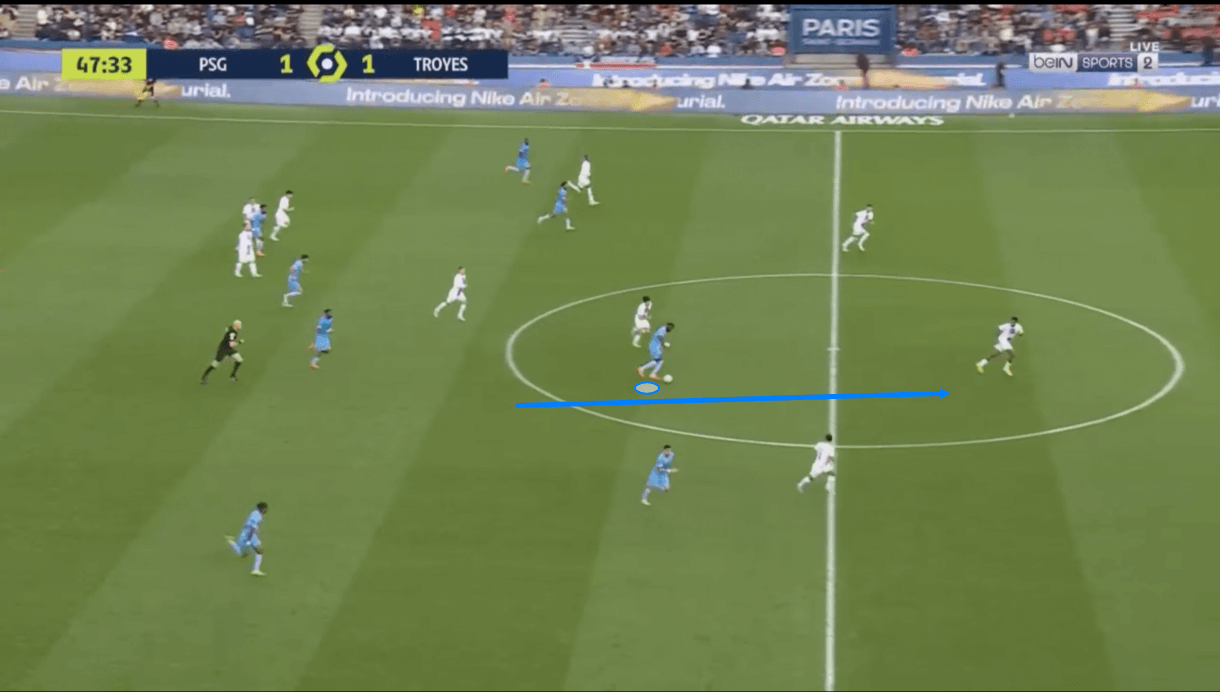
We wouldn’t call Baldé the most technically-proficient dribbler in the world; the ball will sometimes get caught under his feet, for instance, or his dribbling may come across as being a bit ‘clunky’ or not quite as smooth as the likes of fellow Ligue 1 attacker Kamaldeen Sulemana, for example, who’s very smooth with his ball-carrying.
However, Baldé is dangerous when carrying the ball forward with space to run into, as we see in figure 4. Give Baldé space to accelerate and drive at the defence, and he can be an excellent asset. He’s typically brave with his ball-carrying and likes to drive at the defence but relies on having space to knock the ball ahead of himself and move full-steam ahead.
In this passage of play, Baldé drives his side all the way to the edge of the opposition penalty area, taking it past one defender 1v1 before eventually being dispossessed on the edge of the box. However, his power with the ball, dribbling quality and bravery were all crucial in his progression.
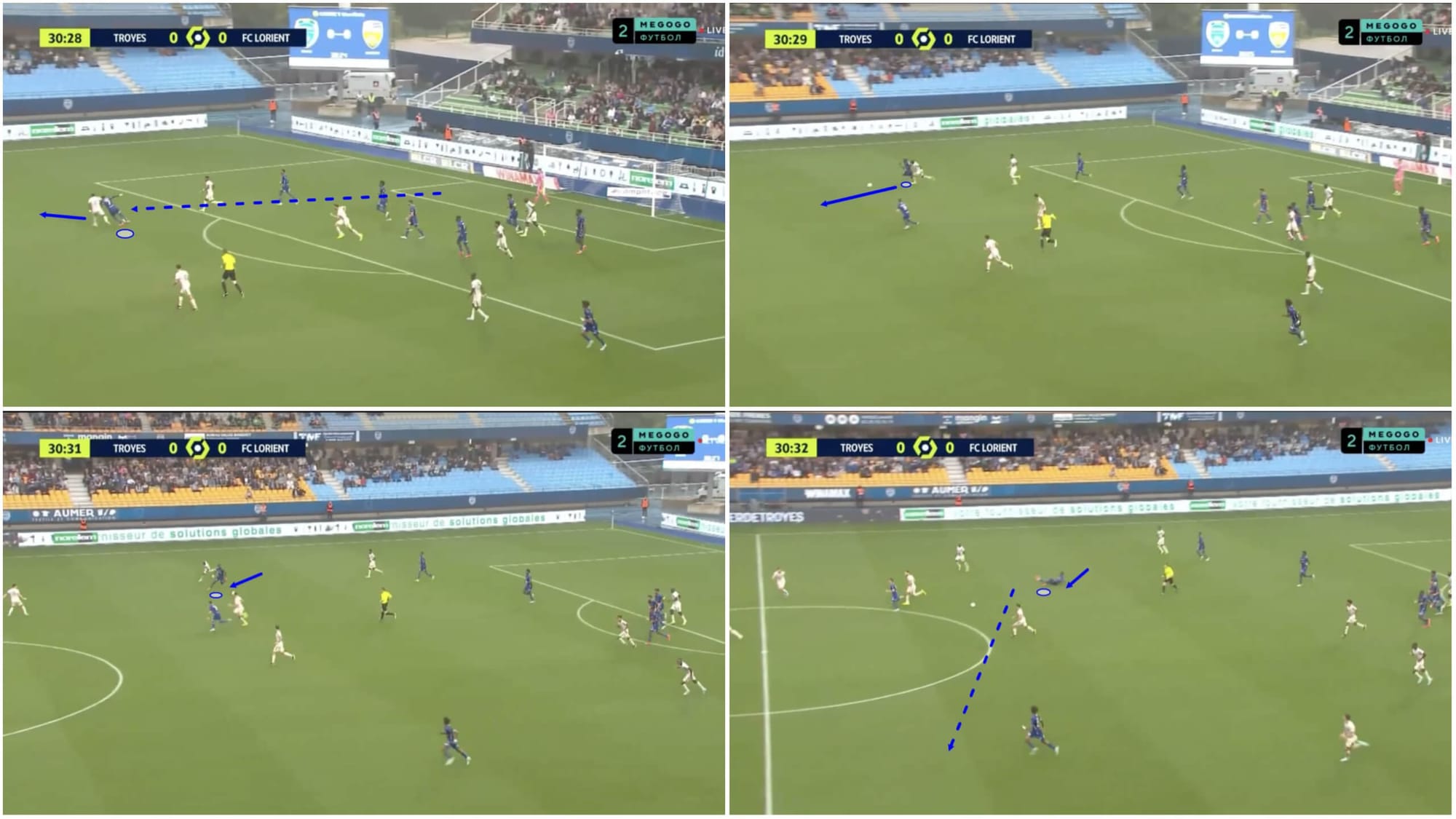
Like in figure 2, we see Baldé picking up the ball on the edge of his team’s own box just after the defence has cleared the ball as we move on into figure 5. Additionally, like in figure 4, the player has plenty of space ahead of himself to accelerate into. However, in this example, we see Baldé has a defender challenging him almost immediately.
As he approaches the ball, Baldé leans into this defender before knocking the ball around him and chasing it down, continuing to keep the defender away from the ball with his body while carrying it forward. The defender tries to go around Baldé but the attacker continues to move forward and turn towards the centre, ultimately shrugging off the defender and carrying on with his carry unhindered.
The pass at the end of this move to release a teammate into space on the opposite side of the pitch is played while off-balance but does still reach its mark, though the pass could’ve had a bit more weight on it and could’ve been played a bit further in front of his teammate sprinting forward on the opposite side.
This passage of play shows us two key things about Baldé’s game that we’d like to touch on.
Number one, when it comes to his ball-carrying ability, a key strength for Baldé is his strength and ability to carry the ball forward with pace while still using his powerful frame as a barrier between the defender and the ball. Especially when carrying the ball forward in transition is such a key part of his role at Troyes, this is a useful skill for the forward.
Number two, Baldé’s passing ability is an area with plenty of potential for improvement. He’s not a great playmaker and when required to play through balls into his teammates’ path, as we saw in figure 5, the direction of the pass and/or the weight of the pass are often slightly off.
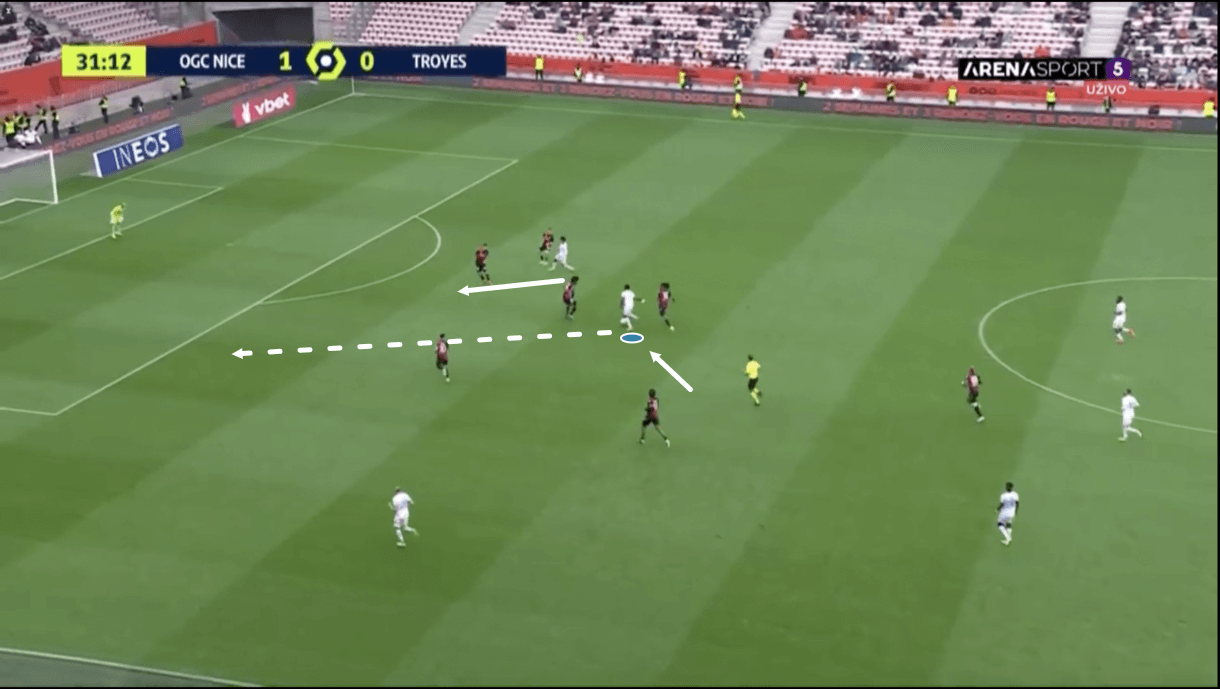
Figure 6 was another case when Baldé’s final ball was lacking. On this occasion, the player has just carried the ball into a good position with a teammate making a diagonal run across the opposition’s backline. As Baldé attempts to slip the ball through to the runner, however, the pass is far too heavy and ends up going to the opposition goalkeeper.
It’s evident that Baldé can work on his final ball and improve his playmaking ability. However, on a positive note, he’s a powerful ball carrier who can perform his role of driving his team forward, particularly in transition, very effectively.
Defensive contribution
Back in figure 3, we can also see that Baldé tends to engage in plenty of defensive duels, winning a relatively large percentage of them. We’ve already mentioned that while Baldé doesn’t press particularly aggressively, he’s still required to press on certain pressing triggers, with defensive awareness and work rate being key for the 26-year-old out of possession. This will be analysed further in this section of our scout report.
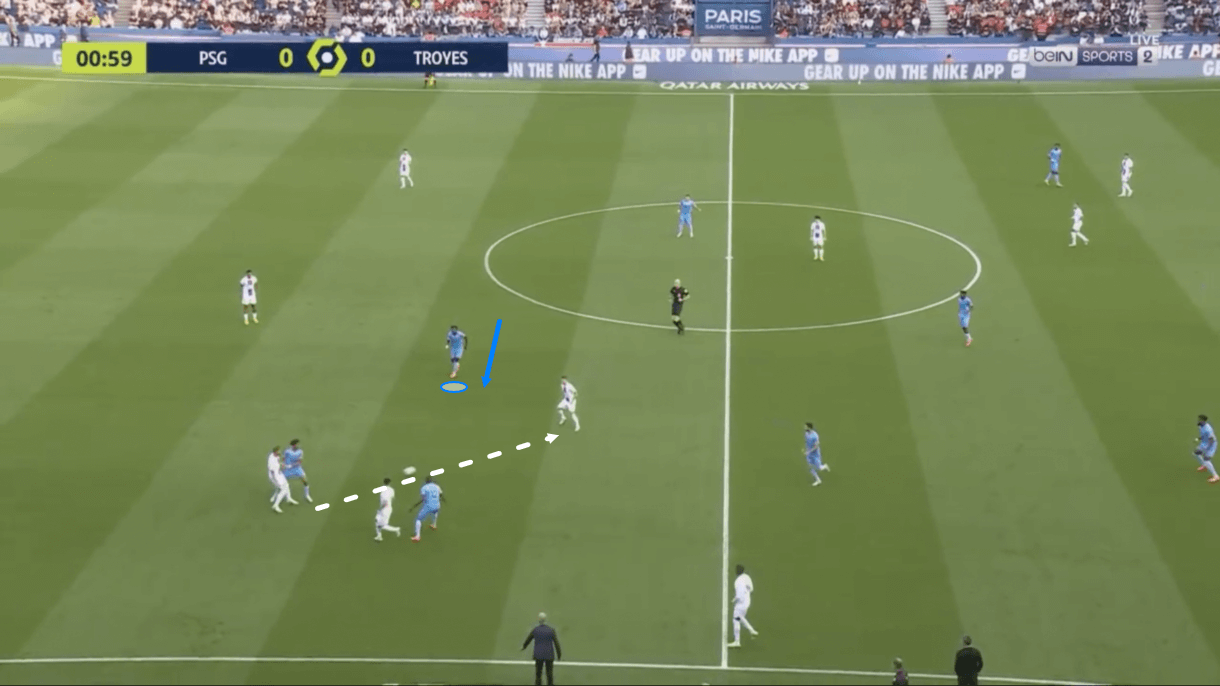
Firstly, in figures 7-8, we can see Baldé pressing an opposition midfielder as they receive the ball just behind him. Baldé doesn’t typically apply much pressure to the opposition’s backline, instead focusing on blocking passing lanes — usually, between the backline and midfield line. If the ball is still played into midfield from the backline, that will trigger an increase in pressing aggressiveness from Baldé, as this passage of play shows.
In figure 7, it’s worth noting that before the midfielder received the ball, Baldé cut the passing lane between the receiver and the centrally-positioned centre-back.
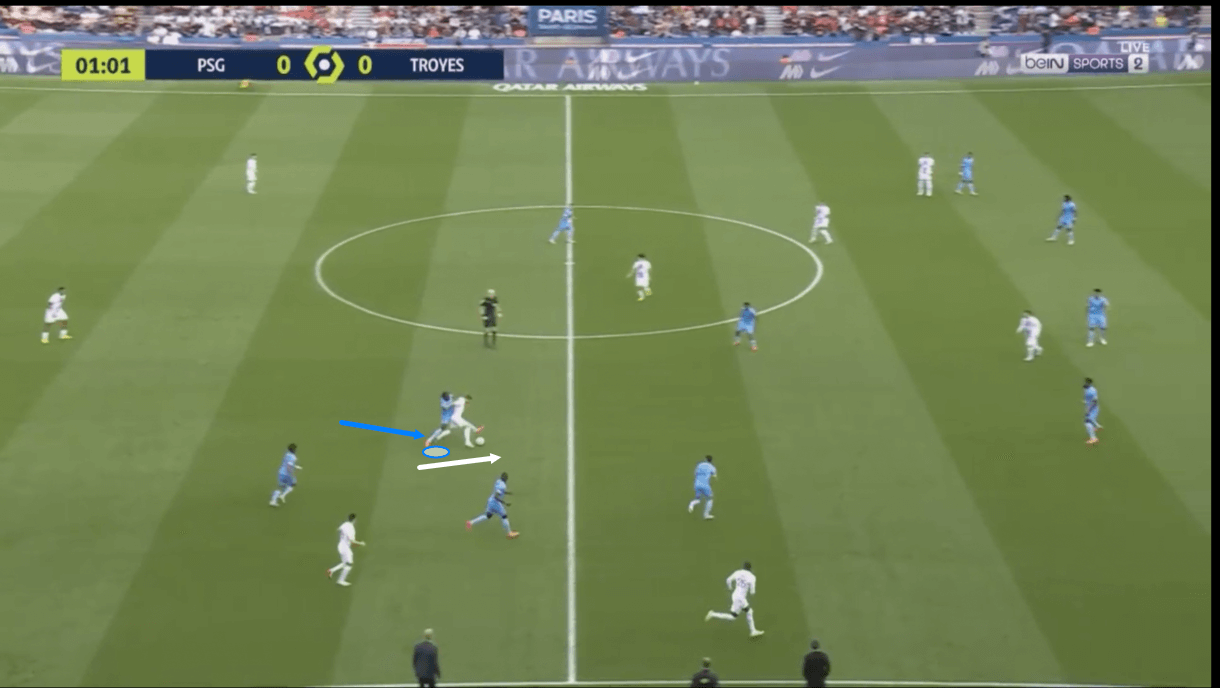
This prevented the receiver from quickly playing the ball to that player who’d be positioned well to spread the ball away to someone in more space. Instead, the receiver was then forced to turn and play the ball forward. However, after turning, Baldé closed the midfielder down from behind rapidly and stuck a foot in to end their progression.
On this occasion, the opposition player was fouled and a free kick was awarded to PSG. However, while it would be better to win the ball cleanly, the most important part of Baldé’s role here is preventing progression one way or another, which he achieved with his intelligent defensive positioning at first, then solid work rate to close the ball carrier down quickly. This is a good example of the forward’s role in the mid-block phase of play.
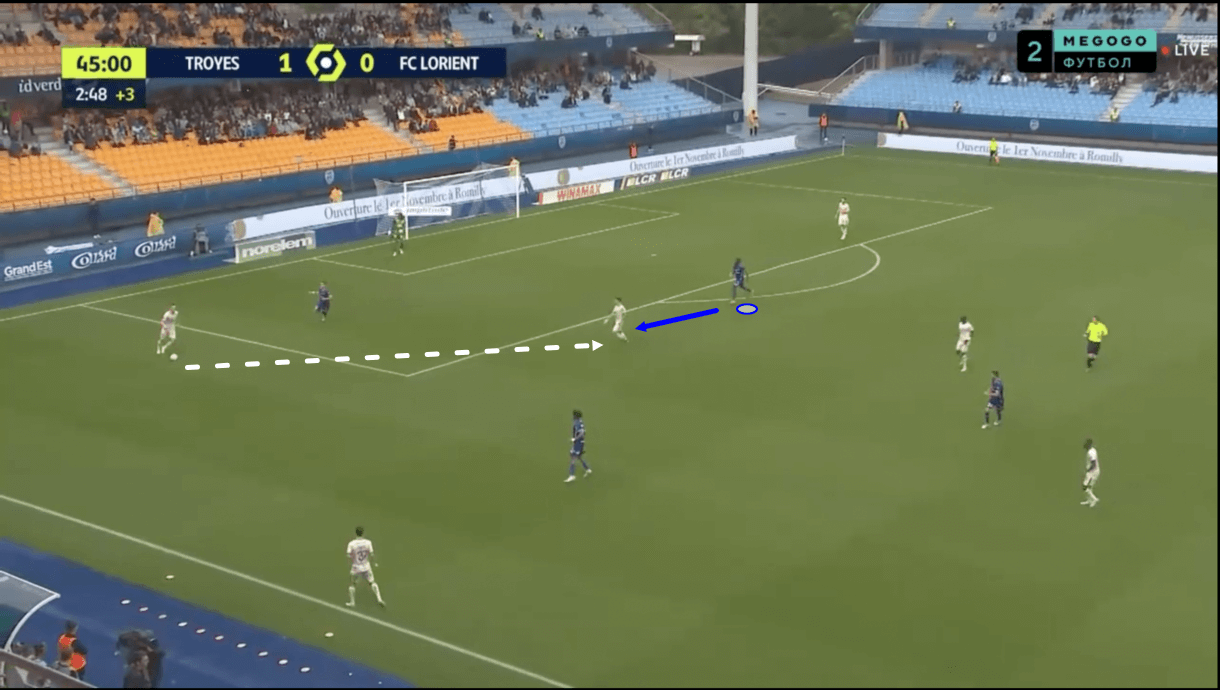
In the high-block, again, Troyes aren’t very aggressive, so Baldé doesn’t typically have as active of a role. However, again, the player will focus on controlling the opposition’s progress into midfield. We see another example of this in figures 9-10, even with the opposition midfielder receiving the ball positioned quite deep. As the centre-back lines up a pass to the midfielder here, we see Baldé already closing in on the receiver from behind.
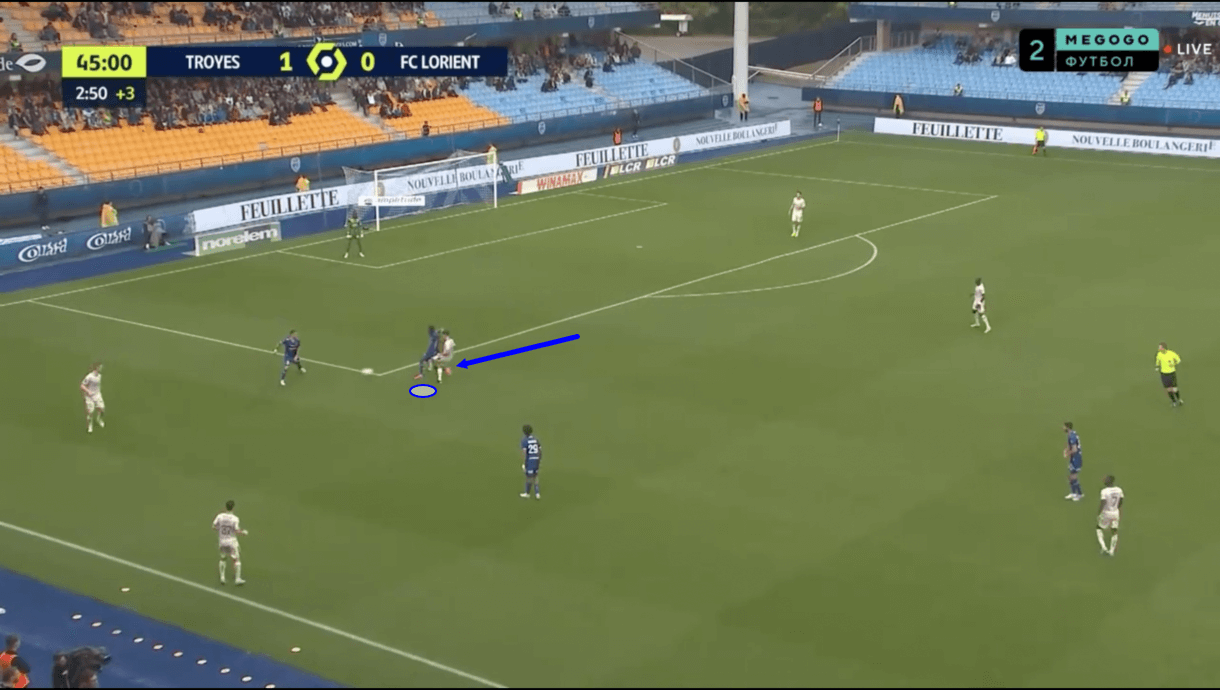
The midfielder tries to turn on receiving the ball but is prevented from doing so by Baldé’s aggressive pressure. Soon after that, the midfielder is dispossessed as Baldé continued closing the player down and then engaged in the defensive duel.
Even in the high block, we may see Baldé get involved if the opposition tries to get the ball into midfield. Controlling the opposition’s progression into this part of the pitch via his positioning and effort is key to Baldé’s role out of possession at all times within Irles’ system.
Attacking movement
The final aspect of Baldé’s game that we’ll discuss in this scout report is his off-the-ball movement in attack. Baldé’s movement to get himself into good goalscoring positions and provide his deeper teammates more responsible for creativity with an option ahead of them has been key to his success at centre-forward for Troyes this term.
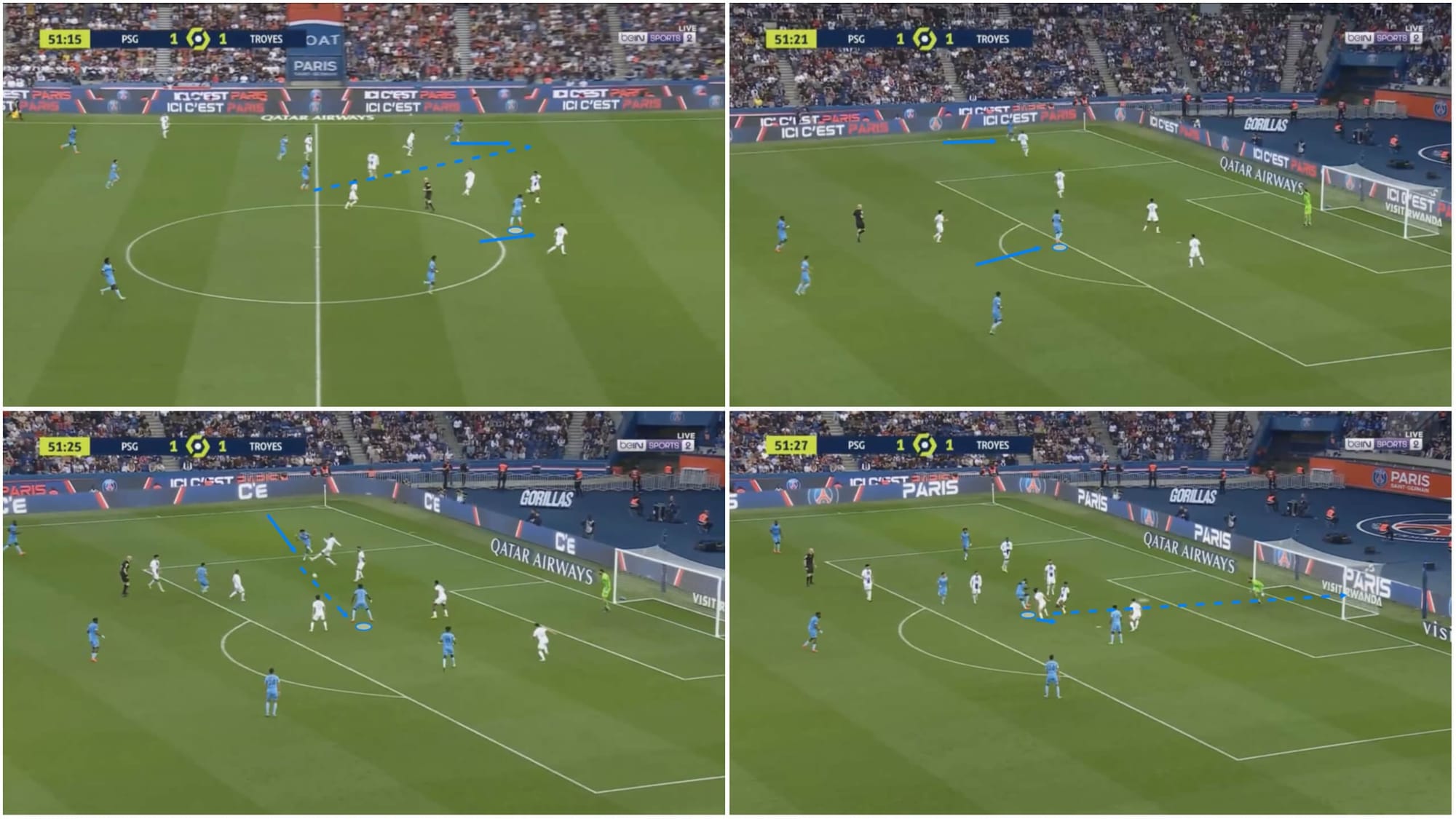
Baldé has been good at creating space for himself in good goalscoring areas, as we see in figure 11. Here, the player is positioned fairly close to the opposition’s centre-backs when the ball is sent through from his central midfield teammate to another teammate on the left wing in the top-left quartile above.
As play moves on, we see that Baldé actually creates more separation between himself and the centre-backs by moving forward rather casually as opposed to busting a gut to stay on the defenders’ shoulders when he no longer needed to, with the left-winger now in a position to carry the ball beyond the opposition’s defence if possible.
This makes Baldé an attractive passing option in the top-right quartile, one that the winger takes as play moves on into the bottom-left quartile. Baldé receives the ball, turns and quickly gets a shot off before too many defenders crowd around him to make getting the ball through to goal impossible.
Baldé loves taking shots on the half-turn like this one, it’s a notable area of his game, and he has thus far demonstrated good ability with these shots, which are becoming something of a signature to his game.
Receiving in space helps to ensure he has enough time to turn and quickly get a shot off as he did here, which is why movement like he displayed in figure 11 where he actually gained space by moving more slowly and casually can be so effective for Baldé. This demonstrates good spatial awareness on the attacker’s behalf.
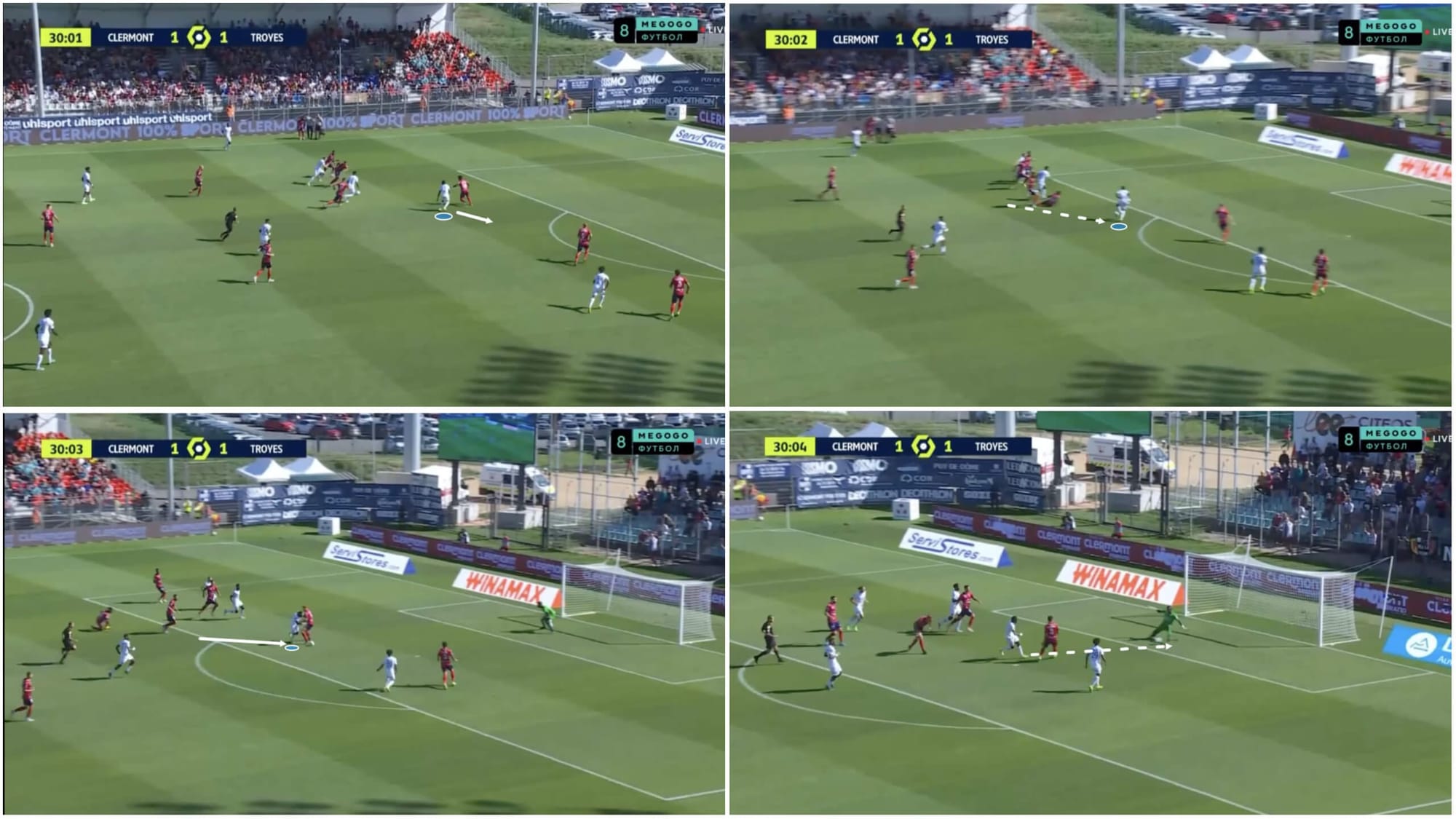
Subtle movement off the defender’s shoulder is another common sight within Baldé’s game to create some space for himself inside the final third. We see a masterful example of this skill in figure 12, where Baldé peeled away at just the last moment before a pass was played by his teammate to his feet, allowing him to receive with his back to goal, quickly turn, carry the ball into a better goalscoring position — demonstrating some good 1v1 dribbling ability to get there — and get a shot off from a high-value location.
This movement was timed very well, while Baldé’s ability to receive on the half-turn here was also impressive.
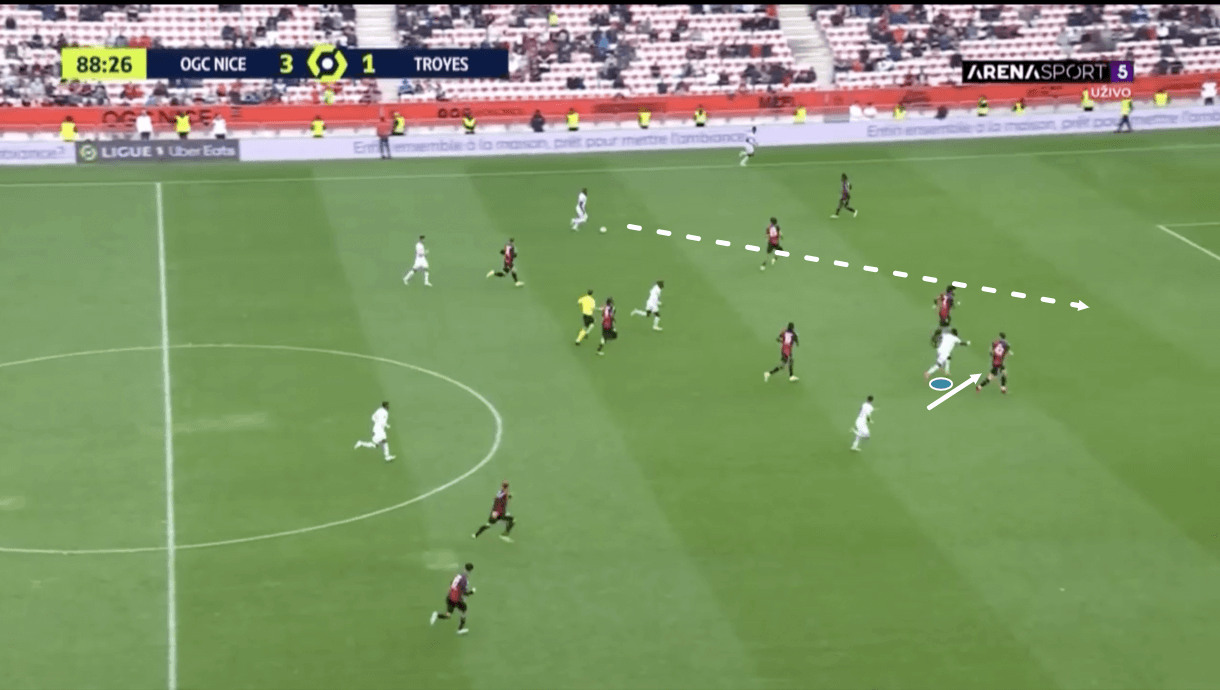
Furthermore, Baldé can be the man to receive the ball in behind the opposition’s backline himself, like his left-winger teammate was in figure 11 when required to perform that role. It depends on what other passing options are available and how good the options at that time are compared to himself in his position, whether or not Baldé will offer himself as the man to receive in behind via a darting run as we see in figure 13, but he’s got the ability to time his runs very well along with electric pace to make himself a problem via these runs in behind.
Baldé demonstrated good vision to see the opportunity to create a good through passing lane for his teammate on the ball via the run in figure 13.
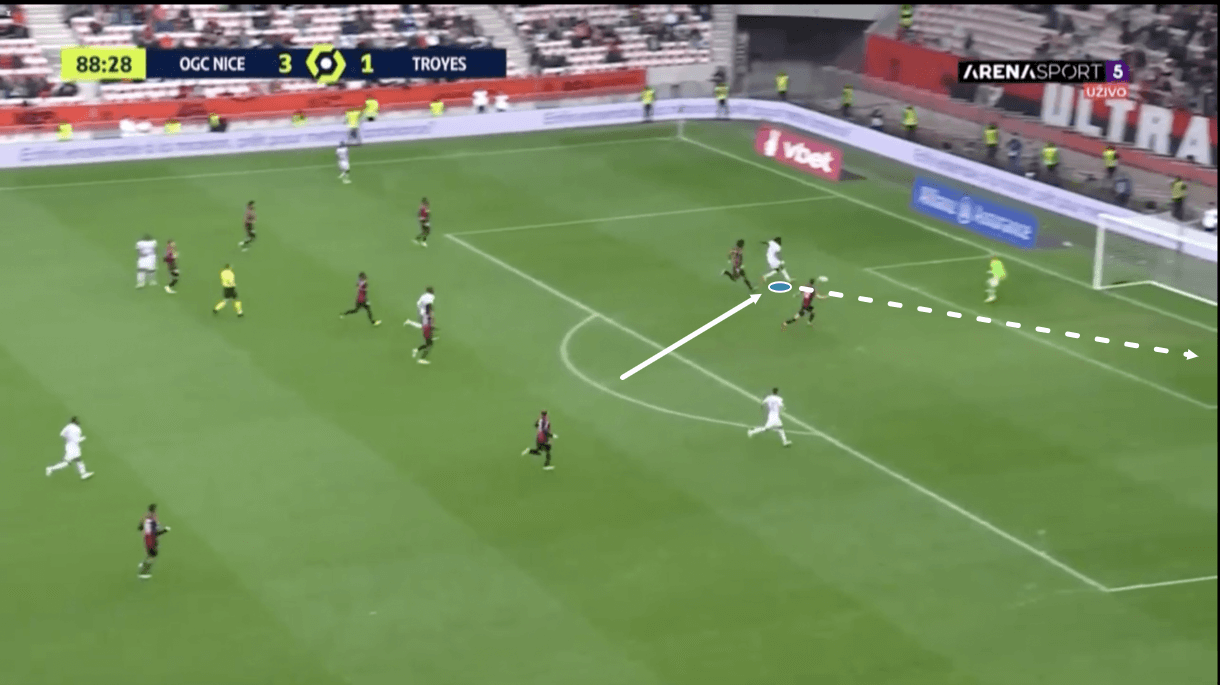
The attacker got onto the end of the through pass in figure 14, enjoying a goalscoring opportunity from a decent location. However, his shot came from his weaker left foot which is evidently weaker than his right foot and just scraped wide of the post.
However, the player’s movement to get into this shooting position was excellent and Baldé’s constant ability to create space for himself and an option for teammates in good positions as we’ve seen in this section of our analysis is a significant reason as to why he’s performed so well for Irles’ side this term.
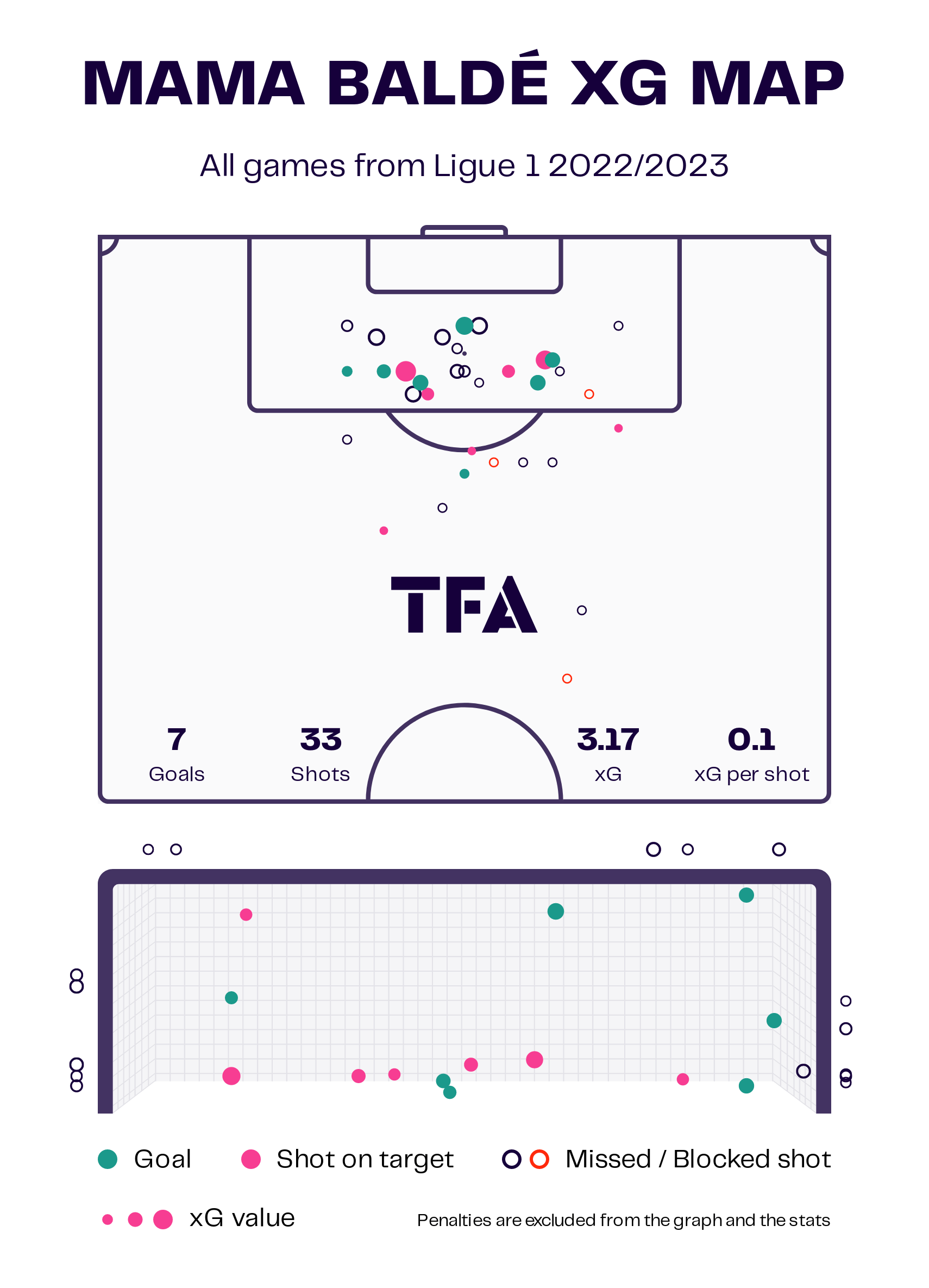
Baldé’s shots generally come from decent locations but, as figure 15 demonstrates, his shot selection and positioning for shots could yet be optimised further. He sometimes takes shots on from very unrealistic locations and takes a bit of a shoot-on-sight approach. One might admire his courage and confidence to take shots on but he could take a better approach to shot selection to be more efficient in this area.
His finishing quality this season has been highly impressive, however, with Baldé demonstrating an ability to pull off some very difficult finishes on the half-turn, first-time shots and volleys.
With that said, better shot selection in terms of location will help Baldé to sustain his goalscoring more in the long-term than relying on wonderful finishes will, though the latter has been fantastic to watch this term for entertainment value.
Conclusion
To conclude this tactical analysis and scout report, it’s clear why Dingomé declared that Baldé has found the perfect role for him this term because, while he’s not a complete forward and does have obvious faults as discussed in this analysis, the forward’s role capitalises on his strengths of ball-carrying, off-the-ball movement and defensive work-rate excellently.
Some areas of his game can still do with some improvement and would make him even more effective in his current role but overall, the attacker’s current role is evidently one that suits him well and this is why he’s enjoyed such a positive campaign at Troyes this term under Irles, who’s utilising Baldé effectively.





Comments